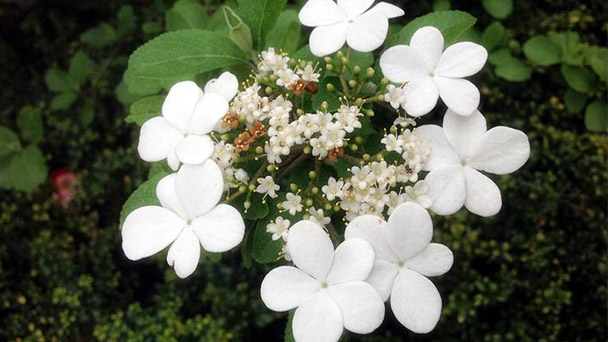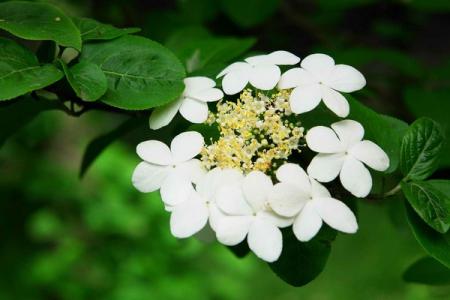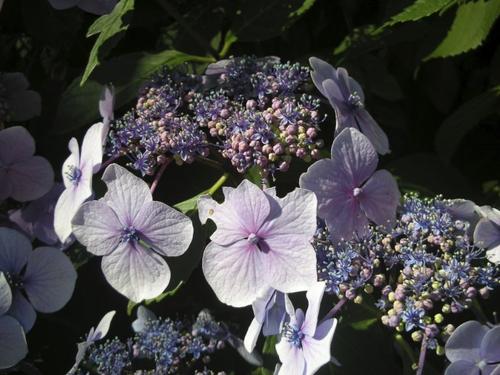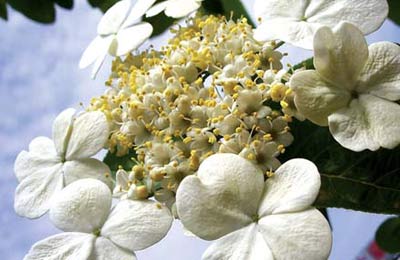Viburnum macrocephalum Fort. f. keteleeri profile
Written by Maggie
Nov 16 2020

Viburnum macrocephalum Fort. f. keteleeri is a plant of the honeysuckle family and viburnum. Deciduous or semi-evergreen shrub, up to 4 meters; the bark of Viburnum macrocephalum Fort. f. keteleeri is gray-brown or gray-white; buds, juveniles, petioles and inflorescences are densely covered with gray-white or yellow-white clusters of short hairs, gradually glabrous . The leaves gradually fall off from the winter to the next spring, and are papery, ovate to elliptic or oval rectangular. Cymes are only surrounded by large sterile flowers, the corolla diameter is 3-4.2 cm, the lobes are obovate or nearly round, and the top is often concave. The fruit is red and then black, oval, about 12 mm long; core is flat, oblong to broad oval, 10-12 mm long, 6-8 mm in diameter, with 2 shallow dorsal grooves and 3 shallow ventral grooves. Flowering period is in April, fruit maturity from September to October.
Viburnum macrocephalum Fort. f. keteleeri picture

Morphological characteristics of Viburnum macrocephalum Fort. f. keteleeri
Viburnum macrocephalum Fort. f. keteleeri is a deciduous or semi-evergreen shrub, up to 4 meters; the bark is gray-brown or gray-white; buds, juveniles, petioles and inflorescences are densely covered with gray-white or yellow-white clusters of short hairs, gradually glabrous . The leaves gradually fall off from the winter to the next spring. They are papery, ovate to elliptic or ovate rectangular, 5-11 cm long, blunt or slightly pointed at the top, round or sometimes slightly heart-shaped at the base, with small teeth on the edge, above At first it is densely tufted with short hairs, only the midrib is hairy, and the lower side is tufted with short hairs. 5-6 pairs of lateral veins, intertwined with each other near the front, together with the midrib, the upper side is slightly concave and the lower side is convex; petiole length 10-15 Mm.
Cymes are only surrounded by large sterile flowers, the diameter of the corolla is 3-4.2 cm, the lobes are obovate or nearly round, and the top is often concave; the calyx teeth of the fertile flower are ovate, about 1 mm long, and the corolla is white and radial. , Diameter is 7-10 mm, lobes wide oval, about 2.5 mm long. Tube length is about 1.5 mm, stamens slightly higher than the corolla. The fruit is red and then black, oval, about 12 mm long; core is flat, oblong to broad oval, 10-12 mm long, 6-8 mm in diameter, with 2 shallow dorsal grooves and 3 shallow ventral grooves. Flowering period is in April, fruit maturity from September to October.
Habitat of Viburnum macrocephalum Fort. f. keteleeri
Viburnum macrocephalum Fort. f. keteleeri is distributed in southern Jiangsu, western Anhui, Zhejiang, northwest Jiangxi, western Hubei, and southern Hunan, China. Born in hills, hillside forests or shrubs. The garden is also often cultivated. viburnum macrocephalum Fort. f. keteleeri likes a warm, humid, sunny climate, likes light, slightly tolerant to shade, more cold tolerant, intolerant of drought and standing water. Like moist, fertile, well-drained sandy loam.
The reproduction method of Viburnum macrocephalum Fort. f. keteleeri
sowing
Sowing method: Viburnum macrocephalum Fort. f. keteleeri fruit is a drupe in a single fruit. The inner pericarp is extremely hard and is wrapped outside the seed. The seed harvesting period is generally after October, with the black outer pericarp as a sign of maturity. After the seeds are harvested, they should be stored in the sand. The seeds should be taken out during the Qingming Festival the next year, and the pericarps should be washed off, and the seed husks (endocarps) should be peeled off, or part of the seed husks should be worn away, or soaked in 0.1% dilute acid solution for 24 hours to soften the seed husks Sowing, untreated seeds are generally difficult to emerge in the same year. After sowing, cover the soil with about 1.5 cm, if it is pot sowing, water and loosen the soil frequently to make the seedlings emerge as soon as possible.
Seedling management: Viburnum macrocephalum Fort. f. keteleeri seeds after shelling usually emerge after about 1 month. When the first pair of leaves of the seedlings emerge, they should be properly shaded, especially at noon to avoid direct sunlight on the seedlings to avoid transpiration. If the leaves are found to be rolled in, and they recover immediately in the evening, it indicates that the transpiration of the leaves is greater than the absorption of the roots, which is a common phenomenon under hot or drought conditions. Viburnum macrocephalum Fort. f. keteleeri was sown that year, and the seedlings did not grow fast. The second year begins to accelerate the growth significantly. When it grows to more than 10 cm, the top buds can be picked according to the size of the pot to promote the rapid growth of the side buds and prepare for potted planting and grafting.

grafting
The seedlings of Viburnum macrocephalum Fort. f. keteleeri generally take 7 to 8 years to bloom, and if the shoots of adult Viburnum macrocephalum Fort. f. keteleeri are grafted with flower buds, they will bloom in the first year after survival.
The grafting method is: at the beginning of March (before the buds germinate), take the flowering branches of the mother branch (usually the outer branches in the middle and upper part of the crown), and cut a section of about 5 cm in length for the scion. The top bud is ideal. Generally use a high connection method. Place shade after grafting. After the buds of the scion have given off leaves, they are placed directly in the sun. There is a growth correlation between the main stem and branches of Viburnum. When the side branches are highly grafted, the top of the main stem should be cut off to speed up the survival and growth of the scion and make it enter the full bloom period as soon as possible.
Layering
It takes place from March to April in spring. Select one or two-year-old branches near the ground at the base, cut the underside of the buds of the branches, and then bury this part in the soil to a depth of about 10-20 cm. The upper ends of the branches are exposed to the ground. After the lower part takes root, the mother plant is cut away from the lower part of the root and planted separately. High pressure can also be applied in March and April, and roots can be taken in June and July, and can be cut and planted that year.
Cuttings
Viburnum macrocephalum Fort. f. keteleeri hardwood cuttings are generally used in autumn or early spring. Tender cuttings are also easy to root. The method is: take the new semi-ligninized shoots that have stopped growing from the young mother tree and cut them into cuttings of about 5 cm. In the rainy season, the cuttings are placed on a well-drained substrate. Endogenous rooting, the rooting rate can be as high as 100%.
The main value of Viburnum macrocephalum Fort. f. keteleeri
Medicinal use: The leaves and roots of Viburnum macrocephalum Fort. f. keteleeri can be used for medicinal purposes. Jiangxi folk use leaves to treat malaria; it can cure throat ulcers and treat skin itching with external use.
Viewing: Viburnum macrocephalum Fort. f. keteleeri has beautiful trees and peculiar flower shapes, like a group of butterflies dancing, cute, full of round fruits in autumn, red and eye-catching, traditional precious flowers and trees. It is suitable for planting in front of halls, pavilions, under walls and outside windows.

Viburnum macrocephalum Fort. f. keteleeri's plant culture
Viburnum macrocephalum Fort. f. keteleeri is the flower of Yangzhou City. Yangzhou people have a special liking for Viburnum macrocephalum Fort. f. keteleeri. Although the original is no longer there, Yangzhou people regard a flower called Jubaxian as Viburnum macrocephalum Fort. f. keteleeri, which is carefully cultivated and cared for as a city flower. In the Daming Temple of Yangzhou, there is a Viburnum macrocephalum Fort that was planted during the Kangxi period of the Qing Dynasty. f. keteleeri, has a history of more than 300 years.
Viburnum macrocephalum Fort. f. keteleeri is also the city flower of Kunshan City. Tinglin Park where the civilization of Viburnum macrocephalum Fort. f. keteleeri is planted and has become a must-visit place for tourists. The largest of these trees is 350 years old and can be called the highest of Viburnum macrocephalum Fort. f. keteleeri.
Latest Updated
- Benefits of Bugleweed - 7 Science-backed Health Benefits
- Bugleweed Dangers & Side Effects - Is It Poisonous?
- How to Plant Evergreen Trees - What You Should Know
- When to Plant Evergreens - Grow Guide for Evergreen Trees
- 12 Wonderful Evergreen Shrubs for Your Garden
- 12 Popular Evergreen Plants with Pictures for Beginners
- When And How To Prune A Lilac Bush Like a Pro
- How to Grow & Care for Lilac Vine (Hardenbergia Violacea)
- Japanese Lilac Tree (Syringa Reticulata) Care & Propagation Guide
- Shumard Oak Pros and Cons - What to Know
Popular Articles
- Winter maintenance of Antirrhinum Majus
- How to Grow Terminalia Mantaly Tree
- How to Grow and Care for Crossostephium Chinense
- How to grow Antirrhinum Majus in spring
- Peristeria Elata (Dove Orchid) Profile: Info & Care Guide
- Underwatered Snake Plant (Sansevieria Trifasciata) - Signs And How To Fix
- How to Care for Brazilian Jasmine Plant (Mandevilla Sanderi)
- How to Grow & Care for Graptopetalum Purple Delight in Summer
- Rosa Chinensis (China Rose): Plant Growing & Care Tips
- How to Care for Baby Sun Rose (Aptenia Cordifolia)